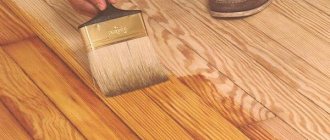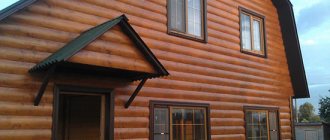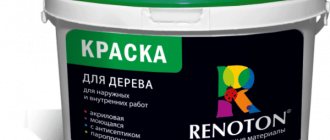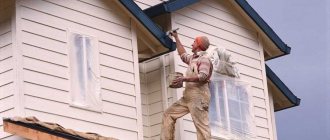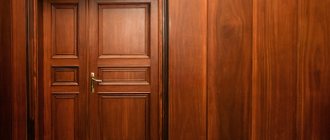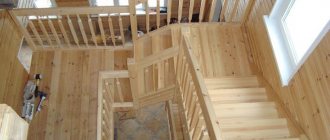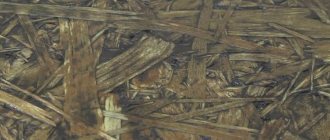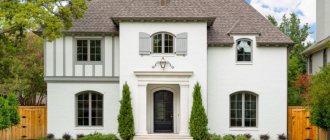Despite the modern abundance of various building materials, wooden houses remain traditional in almost all regions of Russia. From time immemorial, their log houses were erected in both urban and rural areas. Nowadays, the possibilities of using wood have expanded significantly - today, processed timber is widely used for the construction of residential buildings, frame structures made of lumber and plywood or chipboard (OSB) are used.
Painting a wooden house inside
Every home owner, when choosing natural wood or materials based on it to build a house, wants it to retain its original qualities for as long as possible. Therefore, painting a wooden house inside, as well as outside, is a mandatory process to create conditions for long-term operation of such buildings. In addition, this significantly expands the horizons in the possibilities of both external and interior design.
Features of the harmful effects of the environment
A wooden house is exposed to negative influences not only from the outside, but also from the inside.
The destructive factors are:
- High humidity. It leads to cracking and swelling of the wood material, its subsequent deformation. Dirt accumulates in damaged areas, fungus and mold develop. With frequent exposure to moisture, the timber darkens, and the structure itself loses its visual appeal.
- Temperature changes. They lead to warping of the wood.
- Biological factors. Some insects can severely damage the structure of the timber, making it unsuitable for further use.
To select a protective and decorative coating, the totality of all negative influences is taken into account. Since the work is carried out inside the structure, the safety of the compositions for human health is important.
Wood preservatives
Painting wooden walls is a very difficult task. Before starting work, you should correlate your desires regarding the appearance of your home with the above-mentioned functions of the paintwork. To do this, you need to know the entire list of materials and tools used in this work.
Before you begin applying the decorative coating, you should prepare the work surface for painting. This procedure is divided into three main operations: mechanical cleaning, grinding, and applying protective materials.
Varieties of painting compositions for exterior use
To protect timber walls from the outside, paint and varnish materials (LPMs), as well as impregnations, are used. The first option is used for decorative finishing of the house. Paintwork materials must be resistant to moisture, temperature changes and ultraviolet rays. Varnishes can be transparent or colored.
Antiseptic impregnations and solutions
The solution forms a protective film on the surface of the wood, so it is often used to treat rooms if their walls will often be affected by high humidity. Impregnations are compounds that penetrate deep layers of wood. Their disadvantage is toxicity, so after processing the timber you need to apply a layer of paint or varnish to it.
The use of these products solves the following problems:
Impregnation to protect against moisture and insects before painting a timber house.
- preparing the house wall for subsequent painting;
- reducing the consumption of finishing materials;
- improvement of adhesion with paintwork materials;
- protection from the negative effects of insects, the development of fungus and mold;
- increasing the fire-resistant properties of timber.
Pay attention to: Removing old paint from metal: methods and principle of operation
Pre-treatment of wood makes it resistant to ultraviolet radiation.
Painting materials
When figuring out how to paint wooden walls inside a house, it is important to remember: all types of coatings are divided into two large groups. The first is tinting, protective and other means that preserve the natural texture of the material. The second (covering) – completely paint over the wood in a single color, hiding the origin of the material.
The first group includes:
- stain (stain) – compositions on a water, alcohol, wax or other (solvent) basis. Available in powder, liquid concentrate or ready-to-drink form. They penetrate deep into the wood layers and create a color different from natural. Usually they give lumber a more “expensive” look, imitating valuable wood species. Colorless stains are produced that have only protective properties;
- impregnations - substances that penetrate deep into the material, water-based or other based (oils, waxes, solvents, alcohols), changing its properties to improve performance characteristics. There are antiseptic, fire-retardant, moisture-proof, tinting, combined options;
- varnishes are a finishing coating for wood that has been pre-treated with stain or impregnation, increasing the protection of the material and increasing its attractiveness. Varnishes are available in matte, semi-matte, semi-gloss, glossy, on different bases, for different applications. Forms a film impermeable to air.
The second group (coating paints) is divided into:
- natural (based on natural oils);
- synthetic - enamel (oil and alcohol); - acrylic; - alkyd; - polyurethane.
In addition to coatings intended for painting wood, you can use general-purpose options - water-dispersed, oil-based, and so on.
Important: painting the inside of a wooden house is carried out after preliminary surface treatment (cleaning). The primer or filler used to prepare surfaces for finishing must be compatible with the coating being used.
Types of paints for timber houses
Each finishing material has qualities that you need to know about in order to choose the appropriate composition based on the technical features of the structure.
Latex
It has good aesthetic properties and performance characteristics.
The paint has the following advantages:
- dries quickly (1-2 hours per layer);
- reliable adhesion to a wooden surface;
- environmental friendliness, absence of toxic components in the composition;
- hypoallergenic;
- high resistance to direct sunlight, precipitation, weather fluctuations;
- good vapor permeability;
- resistance to mold and mildew (if the wood is pre-treated with an antiseptic);
- mechanical strength;
- high degree of elasticity;
- the ability to use any detergents to clean the surface.
But latex paint does not withstand frost well.
Acrylic
This paint for timber is expensive, but the price is justified by the good quality.
Advantages:
Types of paint for painting a house made of timber.
- short drying period;
- service life - 20 years, since the substance provides good adhesion to the surface;
- resistance to aggressive factors;
- no strong odor;
- integrity of the layer even with minor deformations of the base;
- the ability to change the shade of the composition;
- moisture resistance, good vapor permeability;
- safety.
If a can of paint is opened for 6 hours, it loses its characteristics.
Oily
Among the advantages of the product are:
- low cost;
- good grip on the surface;
- variety of shades;
- resistance to temperature changes and moisture;
- Possibility of application on pre-painted surfaces (not with water-based paint).
But when working with paint, a pungent odor is felt, the layer takes a long time to dry, and quickly fades in the sun. The finish needs to be updated periodically. Also considered a disadvantage is poor vapor permeability, so natural air ventilation in the room deteriorates.
Alkyd
Paint based on alkyd resins, in addition to low cost, has the following advantages:
- moisture resistance;
- quick drying;
- long period of operation;
- resistance to temperature changes and frost.
But paintwork materials have poor adhesion to wood surfaces. The base for application must be dry, and this requirement cannot always be met for external walls.
Rubber
This type of paint is produced on a polymer basis, so the paintwork material is free from most of the disadvantages inherent in other compositions.
Pay attention to: How to paint a guitar
Among the advantages:
- good adhesion to the surface of a wooden base;
- resistance to vibration and mechanical loads;
- good elasticity, strength;
- ability to form an even layer;
- Possibility of application using different tools;
- additional waterproofing;
- high level of vapor permeability;
- dissolution with water;
- quick drying: completely hardens in 1.5-3 hours;
- resistance to atmospheric changes, ultraviolet radiation;
- safety;
- long service life;
Rubber paint for wooden walls
This paint is expensive, but is of high quality. It must be applied in a thin layer.
Why and how can you paint wood?
The wooden house itself has an attractive appearance. The texture and color of the material, one might say, does not need improvement. But still, all experts recommend covering wooden surfaces with various paints and varnishes.
Why is this necessary? The fact is that wood is a natural material. And everything natural, even after drying, still remains an attractive environment for various biological species. Molds and some types of insects thrive on wood.
In addition, wood allows walls and other elements of the house to breathe. On the one hand, this circumstance helps, but on the other, it can harm. The hygroscopicity of wood can play a bad joke. Over time, surfaces warp or collapse. In addition, this material does not tolerate temperature changes well.
All of these negative characteristics can quickly ruin your new home. To prevent this from happening, all surfaces are treated with various paints and varnishes.
What can be used to protect wood? There are several options here, namely:
- First of all, oil paints come to mind. Such materials perfectly protect the surface from external influences. But oil paints have several serious disadvantages.
Firstly, they completely cover all the beauty of natural wood. Secondly, oil paints take a long time to dry and at the same time emit an unpleasant odor;
- special impregnations. These materials are for protection purposes only. Such impregnations do not change either the texture or color of the wooden surface. Their main goal is to protect the material from biological hazards and fire;
- various varnishes. Here you can choose both translucent and completely transparent options. Varnishes perfectly protect wood from external influences, without spoiling its natural beauty.
When choosing a material for interior painting work, you should be careful. The fact is that the interior is poorly ventilated, so varnishes and paints must meet the following requirements:
- they should not contain toxic substances;
- must be environmentally safe for both human health and the health of domestic animals;
- paints and varnishes should not have a strong odor. This is especially important if people already live in the house. If the smell is too strong, problems with the well-being of household members may arise.
Note! In terms of safety for health and the environment, water-based paints and varnishes are excellent.
Such substances dry quickly, highlight the natural texture and colors of wood well, plus they do not have a pungent odor or toxic components. Another advantage of such paints is their low cost.
Alkyd paints and varnishes have become very popular lately. Thus, urethane-alkyd substances are often called the best material for yachts. The fact is that such varnishes perfectly resist various external influences, both mechanical and chemical. This coating can easily withstand even sea water.
Note! Alkyd paints and varnishes have a slight drawback; such substances take a very long time to dry. It may take a day or more from painting to the possibility of further work.
Whatever paint and varnish options you choose, it is very important to apply them correctly. Otherwise, such coverage will not last long enough, which means all your costs and efforts will be wasted.
Main stages of painting
Painting timber involves the following steps:
- Removal of old coating and dust.
- Sanding with coarse sandpaper.
- Application of a protective composition.
- Grinding.
- Surface primer.
- Fine grinding.
- Applying a paint layer.
Impregnation helps to raise the pile on the wood, so the surface must be dried, sanded and coated with a primer.
Preparing for painting
Includes not only surface treatment, but also paint preparation. If the finishing material needs to be diluted, then this should be done according to the instructions indicated on the packaging.
The wall is prepared next. You need to vacuum the inside of the house, as well as the area between the logs. Remaining dirt can change the color of the finish. The wood also needs to be sanded. There should be no lint or roughness.
Recommendations
The first thing that needs to be said is that you should not neglect high-quality pre-treatment of the wall before painting. This happens quite often, and then home owners are forced to redo everything all over again, wasting time and money. You should also select paint and varnish materials that are as harmless to human health as possible. This will be especially important for interior finishing work.
Another piece of advice is that before purchasing, you should carefully study the information on the packaging of the material in order to clearly understand its properties and characteristics.
Compositions for interior painting works
Finishing materials used for interior work differ from paints for exterior use in technical characteristics.
Wax and mastic
Wax is used to protect timber from the negative effects of moisture and prevents rotting. The substance increases the service life of wood. This product makes the walls stylish, provides a presentable appearance, but has a high cost.
Mastic is a cheaper material. After its application, a velvety surface texture is obtained. Thanks to this effect, it is possible to enhance the grain of the wood and hide minor defects.
Coating walls with wax serves to protect against moisture and mold.
Lucky
The material is low cost. The varnish can be matte or glossy. First you can apply the first type, then the second. But this finishing material does not allow the walls to “breathe”. Good ventilation will help get rid of the deficiency.
There are the following types of varnishes for painting timber from the inside:
- Acrylic.
- Alcohol. Creates a high-strength glossy layer. But they have low resistance to moisture.
- Polyurethane. They have good adhesion to the surface.
- Oily. They create a durable layer, but do not allow air to pass through.
Pay attention to: How to repaint lacquered furniture with your own hands
When choosing a varnish, craftsmen take into account its purpose.
Several options for painting interior walls
Compositions from different manufacturers are suitable for different options. The main thing is to purchase proven products from reputable companies. These include, for example, Teknos, Tikkurila, Osmo, Sikkens (AkzoNobel), etc. For example, let’s take Teknos products; they can be replaced with any analogues. It is better to use antiseptics and paints from the same manufacturer for work. This way there will be no unexpected chemical reaction.
Coating with acrylic interior varnish
To work you will need:
- Antiseptic for wood on a single base, for example Teknol Aqua 1410-01.
- Acrylic varnish transparent or tinted, for example Teknos Natra or Pnelli Lac.
- Brush or roller.
Work progress: the walls are cleaned of dust and sanded. Then the entire surface is treated with an antiseptic in 2 layers. After drying, varnish is applied. The color of the varnish can be selected using special color cards, which are available from all major sales representatives. The varnish must be applied in 2 layers, with the second applied after the first has completely dried.
A common mistake when painting is applying the varnish unevenly. The result is a “camouflage” color effect on the walls and ceiling. This can be prevented by making 3 thin layers instead of 2. It is good to use such a coating for the construction of a house made of profiled timber.
Professional glaze painting
To work you will need:
- Antiseptic composition, for example Teknol Aqua 1410-01.
- Professional water-based glazing primer can be tinted, for example Aqua Primer.
- Colorless water-based interior varnish, such as TeknoCoat.
- Roller or brush.
Work progress: The surface is cleaned and polished. Then you need to do antiseptic treatment. The selected antiseptic option is odorless and dries quickly, so it is ideal for internal processing of timber. Glaze primer is applied to the dry walls. By choosing a tinted option, you can make the color of the walls deeper and more noble. The coating dries very quickly and goes on smoothly. Everything on top needs to be painted with 2 layers of interior varnish. It will create a protective layer and enhance the effect of glaze soil.
The surface will be velvety with a pleasant shimmer. The durability of such interior painting is 7 years. The cost of materials consumption per 1m2 averages from 130 rubles. According to professionals, this option is also easy to do on your own, but unlike the first, there will be no uneven tinting. The tint goes on smoothly and the surface turns out to be uniform. A large assortment of tinting primer glazes makes it possible to choose a color for any interior.
Wax coating
To work you will need:
- Wood antiseptic Teknol Aqua 1410-01.
- Wood wax with a glaze effect, for example Panelvax, Teknovax.
- Brush.
Progress of work: The walls are cleaned in the same way as in the first two cases and sanded. An antiseptic is applied using a brush. After it has completely dried, wax is applied in 2 layers. Wax can be used either transparent or tinted. Wax painting is done with a brush. This method has one big advantage: the timber continues to breathe, since there is no varnish film on top. At the same time, the wood texture receives water- and dust-repellent properties.
The surface painted with tinted wax has an even transparent color. The walls inside feel velvety to the touch after treatment. The average cost of consumables per 1 m 2 is from 110 rubles. Any of the listed methods is easy to do with your own hands and will highlight the interior interior of a house made of timber.
How to choose a color for a timber house
Paint and varnish materials are glossy, semi-matte, matte.
Recommendations when choosing a finishing color:
- Dark and light oak and walnut are suitable for any structure.
- It is better to use cool shades if the timber is even and smooth. They go with a metallic tone.
- Light colors are suitable for small houses. But they should be 1-3 shades lighter than the natural shade of the wood.
The varnish layer needs to be renewed periodically.
Technology of painting a house made of timber
House painting can be done internally or externally. It not only protects the walls, but also performs a decorative function.
Outside
In order for the paint to stick firmly and for a long time, you need to follow the application technology. For work, a roller with a long handle or a spray gun, a grinding machine, a brush and the selected finishing material are used.
The work is carried out in several stages:
- Preparing the base.
- Surface primer. Executed twice.
- Painting. The composition must be applied 2-3 times. Each subsequent layer is applied after the previous one has completely dried.
The paint can be additionally coated with clear varnish. A brush is used for this. The layer is applied with even strokes in a horizontal plane.
Inside
The work includes the following stages:
- Surface preparation.
- Elimination of small cracks and other defects. They need to be puttied.
- Primer of the base to improve adhesion to the decorative layer.
The paint is applied in several layers.
Tips for choosing coverage
When planning to paint the inside of houses, it is important to decide: what is the purpose of such treatment? Depending on the idea, different options are used. For greater ease of understanding, methods of interior finishing of wooden buildings are presented in table form.
| Reason for painting the inside of a wooden house | Preliminary preparation | Type of coating, its advantages and disadvantages |
| Uninteresting texture of the material, desire to obtain a different color from the natural color of all surfaces | Sealing existing defects with special putty, sanding to a smooth surface, priming | Topcoat paints of any type. They create the necessary color effect and protect the wood from external influences. They hide the natural texture of the material and do not allow it to “breathe” (with the exception of some specific coatings) |
| Highlighting a zone with a color different from the main one | ||
| Restoring the look of old lumber | Thorough cleaning with a grinder or (in case of deep damage) with a plane, sealing defects, grinding. The type of pre-treatment depends on the chosen coating - stain and/or impregnation for varnishes, primer/drying oil for paints | Varnish with pre-impregnation or stain treatment. Highlights the natural texture of the material and protects from external influences. Requires careful surface preparation and maintenance |
| Topcoat paints of any type. Hides stains and color defects, protects the material. They hide the texture of lumber and degrade the natural properties of wood. | ||
| Protecting new wood with a decorative effect | If preparation is insufficient (smoothness, absence of defects), carry out additional procedures - sealing unevenness, grinding, degreasing, removing dust | Varnish of any type (depending on the desired effect) over impregnation (stain) in two or more layers. Highlights the texture of lumber, protects against damage, and retains the natural characteristics of the material for a long time. Reduces the “breathing” properties of wood, requires careful preparation and care |
We also allow the option of treating lumber only with natural impregnation (wax with linseed oil, pure wax, natural oils, drying oil, etc.) without painting the interior of the wooden house. However, it provides a lower level of surface protection and requires maintenance. Once every 0.5...3 years (depending on operating conditions), it is necessary to renew the impregnation after sanding and stripping the wood.


